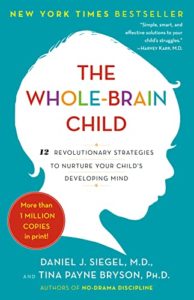Managing Emotions
The last post was on understanding our children as the key to helping them be alert, calm and ready to engage with their world. To expand on that idea, here are some thoughts about what to do when they aren’t calm at all…
 What do you do if your child is yelling at you all the time?
What do you do if your child is yelling at you all the time?
We arrive at the mall, both of my children with me. We’re there to pick up a prescription, but all my son is thinking about is how much he’d like to go play in the children’s playground further down. I kneel down and tell him, “first we buy medicine, then we can play.” I say it more than once, and I wait a little, because I know he needs processing time. Then he lets me guide him to the pharmacy counter.
When we’re done, he happily turns around and marches out of the drug store and into the mall, straight over to the play structure. Shoes and coat come off and he happily runs inside. His sister seems to think she’s outgrown this activity. She hangs back but seems content. Then I notice the sign: “Play Space Closed from 2:30-3:00. Sorry for the Inconvenience.” The current time: 2:25. Uh-oh.
2:30 comes…the other parents coax their children out. I have to go get my boy and carry him out. I show him shoes and coat, and he starts to cry and yell. So does his sister – she doesn’t like it when he’s unhappy.
Sometimes children behave poorly because they think they can push you into giving them what they want. They know that their behaviour can affect yours. If that’s the case, then boundary setting is what’s needed. It can take a little time, but the adage of “we teach what’s acceptable by what we accept” is useful to keep in mind.
But sometimes, especially when they aren’t developmentally ready to see the point of view of other people, kids are poorly behaved because they don’t have the understanding or self-control to do better. We need to help them to learn about themselves and to develop strategies to communicate and manage their emotions. This is made extra difficult when our kids have trouble using words to let us know what they’re feeling and why.
There are two ways of coming at this problem, and you would want to do both.
Plan Ahead
First you’d want to do some proactive things: some teaching around recognizing and managing emotions.
You can help by talking about your own feelings. For example, in daily life, there are times when you feel angry, sad or happy and can share that with your child. This is called “self-talk,” and sounds something like, “Oh, I can’t find my book. That is frustrating.”
In the same way, we can articulate what we see our children are feeling. “Oh, you’re smiling. You must feel happy.” Another way is to talk about emotions expressed in stories or videos. We have noticed our daughter is expressing her own feelings by quoting lines from the books she reads – it seems easier for her than talking about herself.
When your child is calm (NOT during an upset), you can also do some teaching of specific self-calming strategies. They can absorb it when they aren’t on emotional overload already. You could use Social Stories, The Incredible Five-Point Scale, How Does Your Engine Run, or simply make a plan based on what you know will work for your child. With our daughter, we’ve talked about what to do when you’re angry, and made a chart (“When I am upset, I can read a book, have a hug, or be alone.”) Those were options that made sense to her.
Consider other aspects of regulation as well. Is your child sick, tired or hungry when things go astray? There might be ways to schedule daily activities so that your child doesn’t hit trouble at those points when their reserves are low. If they aren’t feeling well, don’t expect them to cope with challenges in the same way as when they are healthy.
For example, you might find one child is reluctant to eat breakfast at the table when his sibling is there too. It’s possible he is thinking, “It makes me upset when my sister talks during breakfast, so I’ll eat my breakfast at a different time or sit at a different table.” This requires some careful observation and understanding of what’s going on for your child. This applies to both nonverbal ASD kids and verbal kids with Aspergers: it’s common for very verbal Aspergers children to find it difficult to explain their feelings and reactions. Which brings us to the next part…
In the Moment
What do you do when your child has lost their cool? Realistically, it takes time for kids to learn how to handle their emotions, and they are going to have out-of-control incidents along the way. It helps to view these as opportunities for practice and for learning.
First try to be a detective. What happened before they were upset? Could it be a sensory problem? Can you find any patterns as to what happens before they get upset? Also, consider what happens afterwards. Has something been avoided? What do they do instinctively as they react? (For example, if they cover their ears, maybe it’s a sound that’s bothering them.)
Second, help them find ways to regulate, or calm themselves. Our kids often aren’t able, or don’t have the self-control to stop, listen, and change what they’re doing when they are already caught up in their emotions.
Keep your reaction calm and don’t overload them with more things to attend to. You can briefly do some self-talk or guiding suggestions, but minimize words. “Joey, you look angry.” You might find it’s better to use no words at all. Language can be overwhelming.
Put into place whatever proactive plans you made. Give them some quiet space. You may need to withdraw from where they are, or guide them to a private spot. If your child is comforted by touch or pressure, though, it might be better to keep them quiet company.
In the case of angry or unhappy outbursts, respond quietly. Rather than telling them what not to say or do, model an appropriate response. For example, my little guy screams when he doesn’t like something, but modeling a quiet “no, thank you” is slowly having an effect. You might gently cover his mouth or signal quiet with a finger over your mouth. I sometimes say “no screaming” but my other child is picking up on that and yelling it, so I have to find a way that doesn’t escalate her emotions as well.
It’s also worth experimenting with distraction. If you can catch it soon enough, a joke, a game they enjoy, or the right kind of physical activity might help them change direction.
Relationships Are The Key
It’s easy to forget about what may be the most important thing. Having a safe, loving and supportive relationship with your child can prevent a lot of emotional difficulty. You can be your child’s safe harbour in a world full of uncertainty. When my daughter was very small, I noticed one day that if I paid attention to her cues that she wanted attention and played with her for 10-15 minutes whenever she approached me, she seemed much happier throughout the day. Now that she’s older, I’m being mindful that she needs connecting time with me right after school; even though she might be upset or sad, just being alone for “down time” isn’t what she needs. Even if our children don’t connect with us in typical ways, that doesn’t mean they don’t need to connect at all. In fact, loving and secure relationships may be what they need the most. We just need to be sensitive to the ways they are most comfortable in relating with us (which can be addressed in our next post on engagement).
Emotional regulation will look different with each child, depending on what’s going on in their lives, their age, and their unique personality and needs. The priorities are to build strong, supportive relationships, to teach them to appropriately express their feelings when they are calm, and to support them when they aren’t.
“It’s OK, he’s just sad,” I say quietly to my daughter. I kneel down to my son as he’s trying to stuff his coat and shoes back into the cubby, and loosely put my arms around him. Quietly I say, “I know, you want to play. It’s fun here.” And I wait. Then I point at the sign. “See, it’s closed. They are cleaning. We could go to the duck park and play.” Wait a little more. He relaxes.
I offer his shoes and coat…and he puts them on. Away we go.
No, it’s not always this easy. But we have established a pattern of listening to our kids and accommodating them as much as we can (and is reasonable), staying calm ourselves, and acknowledging their emotions. It seems to be paying off.
For further reading:
 Siegel, Daniel. The Whole-Brain Child
Siegel, Daniel. The Whole-Brain Child
Growing up is about learning to integrate the logical and emotional parts of our brains. Parents can use ordinary moments of challenge and difficulty to help children grow from rigid and chaotic thinking towards well-being, understanding, flexibility, and stability. Danel Siegel is a developmental psychologist, and in this book he applies current understanding of brain development to parenting, particularly for children from birth to school-age but with suggestions for the teen years as well.
 Baker, Jed. No More Meltdowns.
Baker, Jed. No More Meltdowns.
An easy-to-follow, 4-step model that will improve your everyday relationships with the children in your life: 1) Managing your own emotions by adjusting your expectations, 2) Learning strategies to calm a meltdown in the moment, 3) Understanding why a meltdown occurs, and 4) Creating plans to prevent future meltdowns.
 Greene, Ross. The Explosive Child.
Greene, Ross. The Explosive Child.
Pingback: The “I” in DIR: Knowing Your Kid – ADAPT Manitoba